|
|
|
|
|
Essays On Art
|
|
The Choice: Peace or War
by Ray Strong
(1905-2006)
|
| ....1934 was a productive year for
artist Ray Strong. The native Oregonian, just settled in the San
Francisco Bay area the year before, completed 2 large easel paintings
of San Francisco from Russian Hill and his large painting "Golden
Gate Bridge under Construction" had been selected to hang at the
Corcoran Art Gallery in Washington D.C. All three had been created
under the auspices of the New Deal art program known as the Public
Works of Art Project (PWAP.) He was working on another PWAP assignment,
a 5 by 25 foot landscape mural of the Skyline hills of Santa Clara
Valley for the library of Theodore Roosevelt Junior High School
in San Jose, when he received word that his "Golden Gate" picture
had been selected by President and Mrs. Roosevelt to hang in the
White House. These were all significant achievements for the 29
year old artist. |
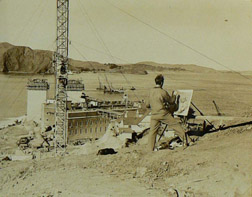 Ray Strong painting the Golden Gate Bridge
during its construction
Ray Strong painting the Golden Gate Bridge
during its construction |
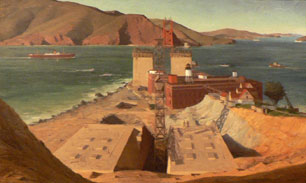 Golden Gate Bridge under
Construction
Golden Gate Bridge under
Construction |
|
|
....Upon completion
of the school's library mural, the students approached
Ray with the idea of creating yet another mural for
their school, to be paid for with funds from a school
paper drive with the plan to match the $37.50 per
week he received from the PWAP. The students gave
Ray carte blanche to develop the design. At that particular
time in Ray's career as an artist, he was actively
engaged in promoting the Cooperative Movement, starting
the San Francisco Art Students League, art gallery,
and art supply store based on cooperative ideals.
He was studying art at the Art Students League in
New York at the onset of the Great Depression and
his firsthand experiences and observations of its
effects spurred his interest in alternative social
and economic theories, including the Cooperative Movement.
Also, like many Americans during the mid 1930s, he
was becoming increasingly alarmed by political unrest
in Europe, particularly the situation in Spain which
would soon erupt into the Spanish Civil War. He decided
to create a design which would graphically depict
the harsh consequences of war on one hand versus the
benefits of peace and cooperation on the other.
|
| ....When Ray presented
his preliminary sketch to the school administrators
and teachers, he encountered opposition predominantly
because of the graphic war imagery it portrayed. The
field of skulls, a skeleton, and sinister hooded figures
were deemed too explicit for junior high students by
some. The principal decided to resolve the controversy
by subjecting the mural to a vote of the students. One
hundred students were picked at random to view the sketch
and then vote whether or not they favored the mural.
The vote tally was 98 to 2 in favor and so the project
moved forward. |
|
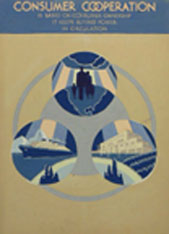 |
|
| ....After three weeks of work, the
"Peace or War" mural was complete. At 5.5 by 13 feet in size, it
was smaller than the enormous library mural at the school, and differed
in that it was portable. Local press coverage of the powerful mural
led to requests for public display outside the school, and so the
mural went on display in the city of San Jose and numerous other
locations around the Bay area over the next four years. In 1939,
it was selected to hang in the Women's Peace Projects Building at
the Golden Gate International Exposition on Treasure Island. It
was there that Mayor Gaines of Berkeley, upon viewing the mural,
called it "The Choice", and the name stuck from that point forward.
The national Cooperative League distributed a pamphlet depicting
the mural at both GGIE and the New York Worlds Fair. Ray gave a
copy of the pamphlet to Upton Sinclair who was then running for
governor of California, and was told that Sinclair kept it over
his writing desk until his death. The school eventually decided
that since the mural seemed to be resonating with the larger community
and hence went on loan much of the time, they offered to return
it to Ray's possession in exchange for 3 large landscape paintings.
This transaction was made in the early 1940s and "The Choice" remained
in the artist's possession until his death in July of 2006. |
|
|
|
Imagery of "The Choice"
|
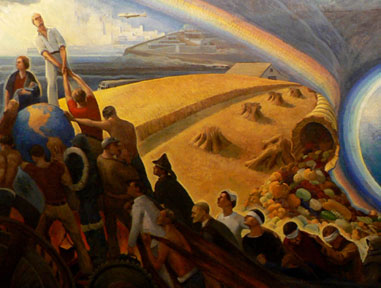
Detail from The Choice
|
....Ray
Strong painted "The Choice" at the home of his father-in-law,
H.C. Brown, a philosophy professor at Stanford. The left portion
of the mural was the artis's vision of a world in which people
lived together in cooperation and peace. At the time the mural
was painted, the artist had become the education director
of the Cooperative League's Northern California Council and
a small Cooperative League emblem (of two stylized pine trees
in a circle) was painted onto the globe on the left side,
now slightly painted over. Ray painted his own likeness in
the mural and is seen as the blonde man in the extreme upper
left corner who is a counterpoint to the scythe-wielding skeleton
who orchestrates the death and destruction wrought by war
seen on the right side. Light illuminates the large, central
globe on the "peace" side of the mural, while the "war" side
remains mostly in shadow and darkness. As some of the wounded
soldiers in the lower center move into the "peace' side they,
are assisted assisted at first by each other and then by a
nurse. The artist's vision of the world is one where cooperation
spurs economic progress in all areas of human endeavor inlcuding
manufacturing, farming, transportation. Workers and other
service professionals become integral to the realization of
technological advances as represented by the futuristic city
seen in the upper left. |
|
| ....On the right
side of the mural, the "war" side, images were derived from
World War I, which at the time was considered to be the "war
to end all wars." In the lower right corner, soldiers bear
the helmets of many nationalities. There is no bright city
of the future hear, but rather endless ruins and conflagration.
An emaciated naked child rests on a wheel representing starvation,
and perhaps further, an unconscious harbinger of scenes to
come with the discovery of concentration camps toward the
close of World War II nearly ten years hence. Huge clawed
hands dig into the globe on the right; forearms covered in
scales of gold coins represent the paralyzation of the world
by concentrated wealth. A procession of three hooded figures
in the lower right represents fear, propaganda, and munitions
manufacturing. Somewhat subtly stated, a tug-of-war between
these three and a group of figures on the other side further
defines the ongoing tension between the two sides of the central
question and that the actual choice between the two sides
rests with the unified efforts of all people to move the world
toward peace. Ray's younger brother, Winston, modeled the
three hooded figures and a number of others in the mural.
A field of skulls provides a grim contrast to the overflowing
cornucopia of food on the left. Other vignettes are more or
less self-explanatory. |
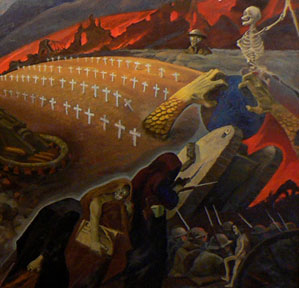 Detail from The Choice
Detail from The Choice |
|
| ....Though this important mural was
created over 70 years ago, its lessons and themes remain just as
contemporary and vital in today's world. While the long and productive
career of the artist was focused primarily on his interpretation
of the natural beauty of the world, "The Choice" is a revelation
of one man's ability to powerfully assert his concerns and fears
for the world in which he lived. More importantly, he offers resolution
based on his heartfelt, optimistic belief in the basic ability of
people to work together toward a common goal for the betterment
of all. |
|
A Gift For Oregon
|
| ....In his later years, Ray began
to envision leaving an artistic legacy to his home state. This idea
was originally inspired by a visit to a permanent display of small
landscape oil sketches of Algonquin Park in Ontario, Canada done
by legenday Canadian artist Tom Thomson in the early 20th century.
During the 1920s, Ray had completed numerous oil paintings, on location
and from a variety of viewpoints of Mt. Hood and other mountains
in the Cascade Range from high altitude, which he visualized as
a collection to give to an Oregon school or museum for a permanent
display. Over the last 20 years of his life, he contacted a number
of institutions hoping to get the paintings placed in a setting
similar to the Thomson exhibit in Canada. In my two and a half years
of interviewing him, from 2004 to 2006, Ray often inquired about
the feasiblity of this idea. I told him that in my opinion it would
be difficult to get an institution in Oregon to dedicate a permanent
display of these works. Instead, I suggested that he might consider
making a gift of "The Choice" to a suitable institution in Oregon.
Ray pondered this idea for a moment and then a wide smile arose
on his face, and lifting an index finger upward he exclaimed, "That
would be number one!" This endorsement set in motion a plan to offer
the mural as a gift and artistic legacy to Oregon. |
| ....Ray Strong died on July 3, 2006.
I visited him a week before his death to reiterate my dedication
to finding a suitable placement for "The Choice." In collaboration
with Ray's heirs, who hope to honor his wishes, I have arranged
for this powerful work to be exhibited in my gallery until an appropriate
home can be found. Essentially, it was Ray's hope that the mural
be permanently displayed in a building that has free public access
to see the mural. Hopefully, the future site for the mural will
be located in one of Oregon's larger population centers, but regardless,
any location that offers stewardship and ongoing display of the
mural as well as free access to view it will be considered. |
....If you have an idea for a suitable
location for "The Choice," I would be happy to discuss it with you.
Until it is placed, the mural will be available for public viewing
during regular gallery hours or by appointment.
© Mark Humpal |
|

